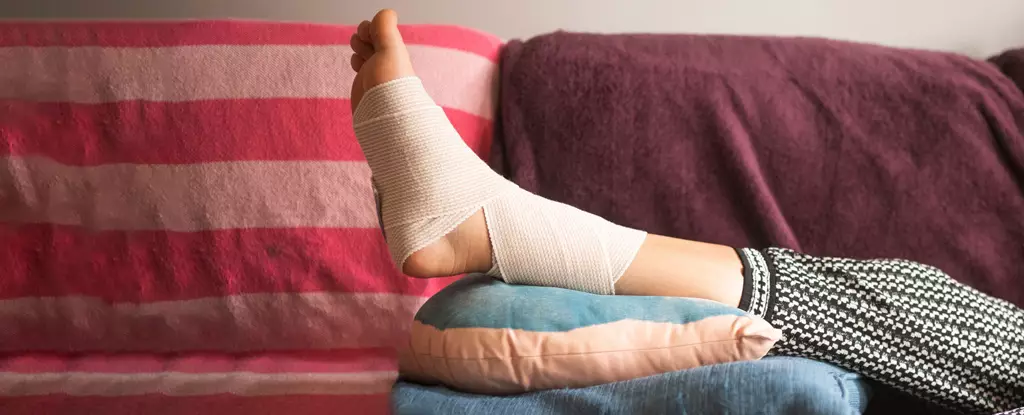When one thinks of an ankle sprain, the immediate association typically revolves around physical damage—swelling, pain, and limited mobility. However, recent research prompts a reconsideration of this injury’s impact, extending beyond the physical realm and into the intricacies of brain function. The concept of brain plasticity, or the brain’s ability to adapt and change in response to experiences—particularly in response to injury—offers a compelling framework for understanding how our bodies respond to physical changes.
Research led by doctoral student Ashley Marchant indicates that alterations in the weight or load borne by muscles can significantly influence our movement perception. Surprisingly, it appears that the closer this load is to normal gravitational forces, the more accurately our brain interprets movement sensations. Conversely, when the muscle load is diminished or altered, our movement sense becomes less reliable. This revelation underscores a crucial need for a paradigm shift in how we comprehend the brain’s role in movement control.
Redefining Rehabilitation and Injury Prevention
The historical approach to preventing and treating sports injuries has predominantly focused on enhancing muscle strength and endurance through methods like resistance training, cardio workouts, and flexibility exercises. Yet, a significant concern in the realm of sports medicine emerges: athletes who have sustained injuries tend to face a much higher risk of re-injury—ranging from two to eight times greater than those without a prior injury. Such statistics indicate that current rehabilitation practices may overlook critical aspects of recovery, particularly those tied to sensory processing and perception.
At the University of Canberra and the Australian Institute of Sport, a groundbreaking approach is being taken to address these concerns. By honing in on the sensory input aspect of movement control, researchers are beginning to uncover how the brain processes information crucial for movement coordination. Notably, sensory input nerves outnumber motor output nerves by approximately ten to one, establishing the fundamental importance of quality sensory perception in overall movement functionality.
Recent advancements in measuring sensory input have paved the way for a more comprehensive understanding of movement perception. Researchers now assess the effectiveness of three pivotal sensory systems: the vestibular system, which governs balance through inner ear functions; the visual system, which responds to changes in light and aids in spatial orientation; and the somatosensory system, primarily informed by receptors located in the muscles and skin, particularly in the lower limbs. By evaluating these systems, a clearer picture emerges of how well an individual gathers and interprets movement-related information.
The implications of these findings are profound. For instance, astronauts experience drastically reduced sensory input from their legs while in microgravity, leading to a rapid deactivation of the neural pathways normally engaged in movement coordination. Consequently, when reintroduced to Earth’s gravity—where they must stand or walk—these individuals become at heightened risk for falls and injuries. A parallel can be drawn with athletes recovering from injuries. Changes in movement patterns that occur post-injury can affect the brain’s perception of how that limb operates, potentially leading to long-lasting alterations in movement control.
The correlation between an individual’s injury history and their risk for future injuries is well-documented, suggesting that something extends beyond mere physical healing when it comes to athletic recovery. It becomes evident that alterations in movement control processes—most likely within the brain—persist long after the injury itself has healed. Additionally, research posits that an athlete’s ability to perceive movement accurately correlates with their performance levels across various sports. Therefore, better understanding and enhancing sensory awareness could unlock new pathways for identifying athletic talent early on.
In older populations, the relevance of sensory perception becomes even more critical. Studies have demonstrated that poor performance on sensory input measures can forecast an increased risk of falls, a pressing concern for the aging population. This connection emphasizes the concept of “use it or lose it,” suggesting that diminished physical activity can lead to a degradation of brain connections essential for movement perception and control.
Technological advancements in tracking sensory ability mark a pivotal shift towards a healthcare model known as precision health. This innovative approach synthesizes various factors—such as genetic predispositions—affecting an individual’s health and tailors interventions accordingly. In the context of movement control, adopting precision health strategies could lead to more focused rehabilitation for athletes, optimized training regimens for astronauts, and proactive fall prevention strategies for older adults.
As we continue to unravel the intricate relationship between physical injuries and brain function, it becomes evident that addressing sensory processing should stand at the forefront of effective treatments and interventions. Enhancing our understanding of movement control not only has the potential to improve athletic performance but could also play a pivotal role in improving the quality of life for those at risk of injury.


Leave a Reply